River Otter
Lontra canadensis
The river otter can hold its breath for up to 8 minutes
Advertisement
River Otter Scientific Classification
- Kingdom
- Animalia
- Phylum
- Chordata
- Class
- Mammalia
- Order
- Carnivora
- Family
- Musteliodae
- Genus
- Lontra
- Scientific Name
- Lontra canadensis
Read our Complete Guide to Classification of Animals.
River Otter Conservation Status
River Otter Facts
- Prey
- Fish, frogs, crayfish, birds, and reptiles
- Name Of Young
- Pups or kittens
- Group Behavior
- Solitary
- Group
- Pair
- Fun Fact
- The river otter can hold its breath for up to 8 minutes
- Estimated Population Size
- Over 100,000
- Biggest Threat
- Loss of habitat
- Most Distinctive Feature
- Long, narrow body
- Other Name(s)
- American otter, fish otter
- Gestation Period
- 58 days
- Litter Size
- one to six
- Habitat
- Ponds, lakes, rivers
- Predators
- Bobcats, coyotes, alligators, raptors
- Diet
- Carnivore
- Type
- mammal
- Common Name
- river otter
- Number Of Species
- 13
- Location
- North America
- Group
- social
River Otter Physical Characteristics
- Color
- Brown
- Skin Type
- Fur
- Top Speed
- 15 mph
- Lifespan
- nine years
- Weight
- 18 pounds
- Length
- 3 to 4 feet
- Age of Sexual Maturity
- 2 to 3 years
- Age of Weaning
- 14 weeks
View all of the River Otter images!
“The river otter is the largest member of the weasel family.“
This species of otter is found across much of Canada and the United States. Identification of this marine mammal is easy, once you realize it is significantly smaller than the sea otter. That isn’t the only difference. While sea otters rarely come onto land, river otters spend significant time on land. They meet in social groups and will frolic along banks and in the water together playfully.
The otter’s heavy coat protects it from the cold, so it doesn’t rely on hibernation to make it through the cold winter months. Winter can be the best time to catch sight of these shy mammals, as they are more active during the day during this time of year.
One of the most significant fun facts about this animal is that it is considered an indicator species, meaning its presence, or absence, can be used to determine the health of a particular environment.
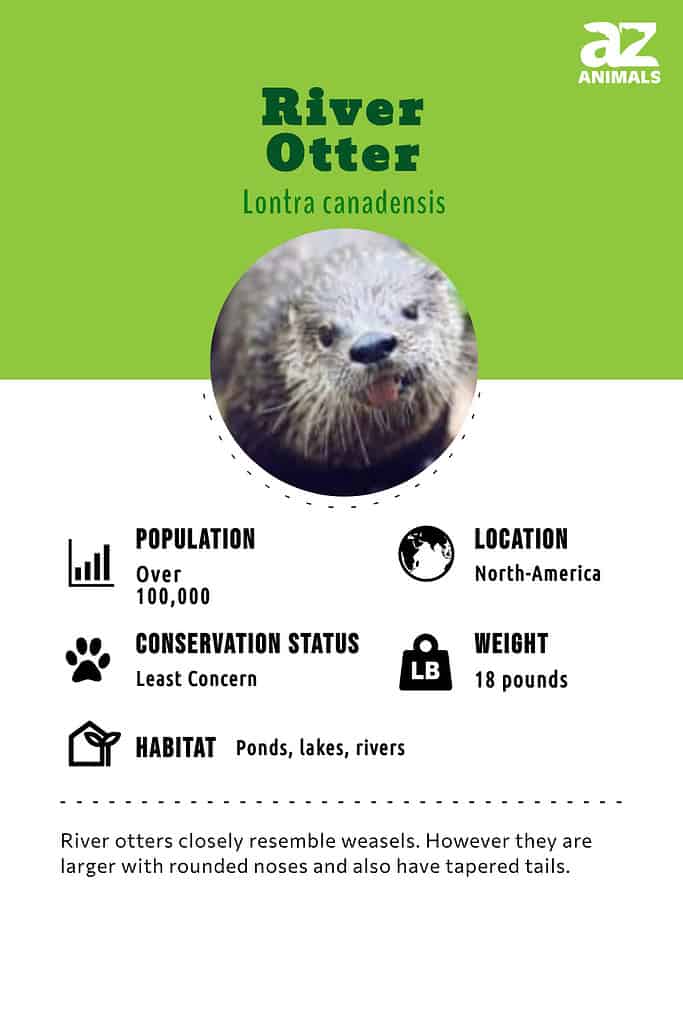
Scientific Name
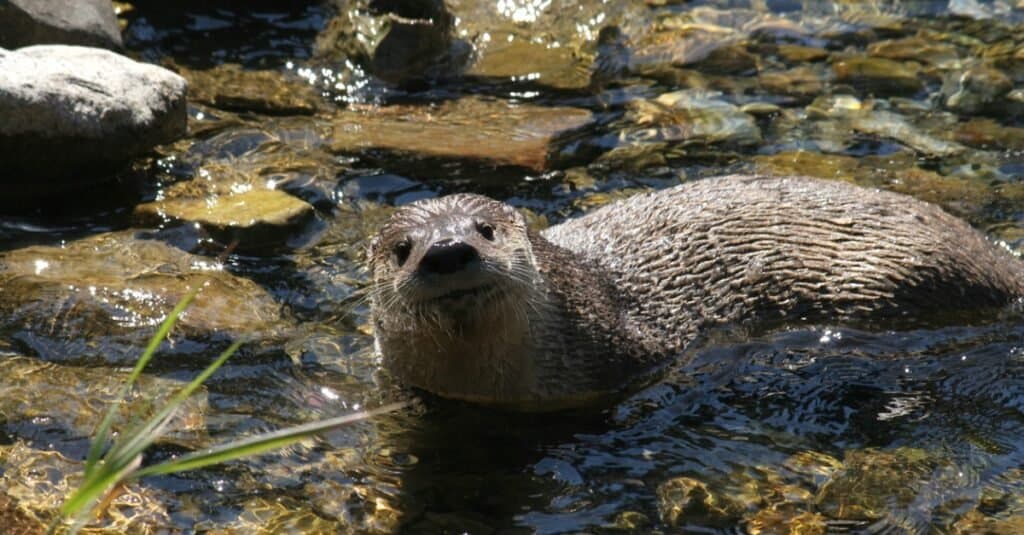
River otters belong to their own separate genus
Lontraalthough they were previously considered to be part of the
Lutra
genus
©iStock.com/MarcQuebec
Lontra canadensis, the scientific name for the river otter, comes from Lontra, which is the genus for American otters, and canadensis, which means “of Canada”. These animals, as well as other American species of otters, were formally included in the Lutra genus. For more accurate identification purposes, the American species were given their own genus, made up of four extant and one extinct species.
Origins
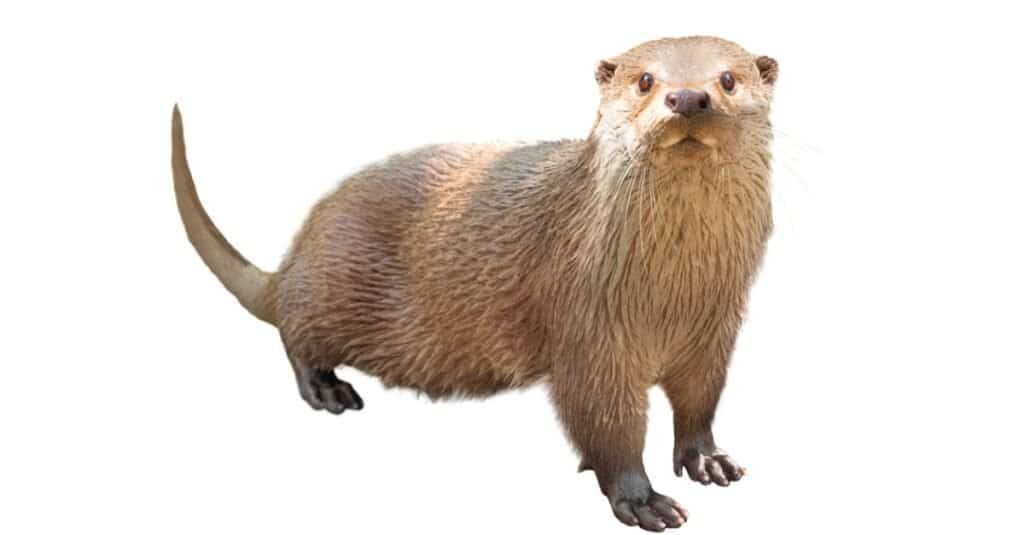
River otters’ forebears arrived in North America at the same time as humans
©iStock.com/bazilfoto
According to paleontologists, the ancestors of river otters arrived in North America at the same time humans did, crossing the Bering Land Bridge which itself first appeared during the Pleistocene era about 1.8 million years ago.
However, scientists have discovered fossil evidence of a giant river otter right in Midwestern America dating as far back as 3.5 million years ago during the Pliocene era. They have also discovered fossil evidence of river otters dating back to 1.9 million years ago also belonging to the Pleistocene period.
As members of the Lontra genus, river otters are also members of the Lutrinae family.
Hence they also share similar ancestry with the following genera:
- Aonyx: This genus consists of the African, Asian, and Congo clawless otters.
- Enhydra: This genus consists of the sea otter which formed a distinct evolutionary branch 5 million years ago.
- Hydrictis: Consists of the spotted-necked otter which can be found in western and central Africa as well as pockets of southeastern Africa.
- Lutra: Consists of the Eurasian otters found in Europe, Asia, and North Africa, and the Sumatran otter found in southeastern Asia.
- Lutrogale: Consists of the smooth-coated otter found in India and southeastern Asia.
- Pteronura: Made up of the South American giant otter, which is capable of reaching almost 6 feet in length.
Types
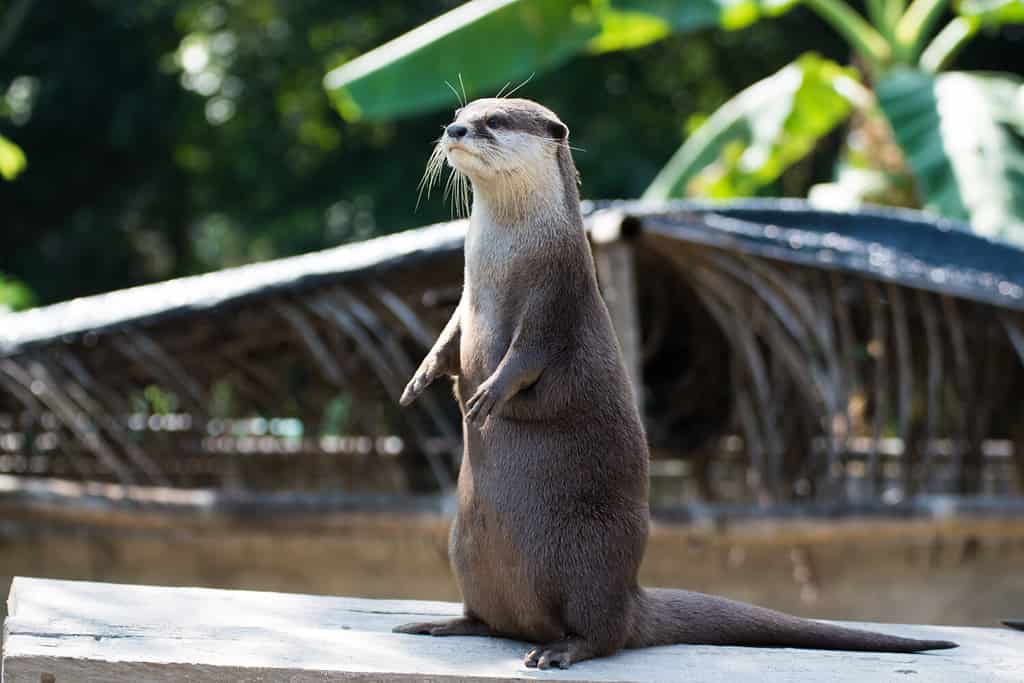
There are seven subspecies of river otter
©Naiplawan Studio/Shutterstock.com
There are seven subspecies of river otter including:
- Lontra canadensis canadensis: These river otters can be found in eastern Canada and in Newfoundland.
- Lontra canadensis kodiacensis: Found on Kodiak Island.
- Lontra canadensis lataxina: Found in the United States.
- Lontra canadensis mira: Found in Alaska and British Columbia.
- Lontra canadensis pacifica: Found in Alaska, California, Nevada, Utah, and Canada.
- Lontra canadensis periclyzomae: Found on Queen Charlotte Islands, British Columbia.
- Lontra canadensis sonora: Found in both the United States and Mexico.
Appearance
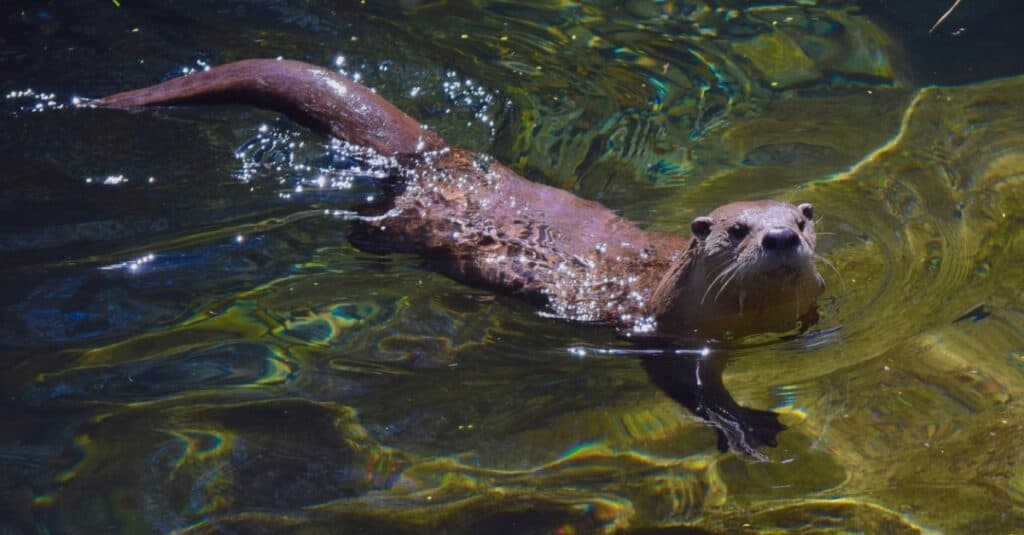
©iStock.com/Kathryn Farley
The North American river otter has adaptations that allow it to spend as much time in the water as on the land. They have long, narrow bodies that taper to the point of their tail. They can close their nostrils, which keeps water out as they swim. Their ears are small and set close to the skull. These otters have short, powerful legs with webbed feet. Their streamlined body and stocky legs allow it to move comfortably on both land and water.
Unlike many warm-blooded animals that spend time in cold waters, they do not have an insulating layer of blubber to keep them warm. Instead, they rely on a thick double coat. Their water-resistant fur must be groomed frequently to provide protection and warmth. Rather than shedding seasonally, they can regulate their temperature by fluffing their fur to trap air, which acts as insulation. Outer guard hairs protect the insulating underlayer.
River Otter vs Sea Otter

Sea otters can grow to almost thrice the weight of river otters and have the densest coat of any mammal
©Kirsten Wahlquist/Shutterstock.com
Identification of the different types of otters in the wild can be a challenge. If you know some fun facts to quickly identify the river otter, you will be able to tell the difference between river and sea otters more easily.
The sea otter is larger than the river otter. While the river otter tops out at around 30 pounds, the sea otter can reach up to 100 pounds. One fun fact that distinguishes between sea and river otters is their coats. Not as easy to recognize as the size difference, the two species have very different coats. The river otter has a double coat, one for warmth and one for waterproofing. The sea otter has a densely packed fur coat. In fact, the sea otter has the densest coat of any animal, with up to one million hairs packed into every square inch.
The swimming and sleeping patterns of the two are different as well. River otters rest and lounge on dry land and swim belly down. Sea otters spend nearly all of their time in the water. They often float on their backs, even eating and napping this way. One of the adaptations the sea otter has developed is its habit of holding hands with its companions while napping. This keeps the partners from drifting apart while sleeping.
Behavior
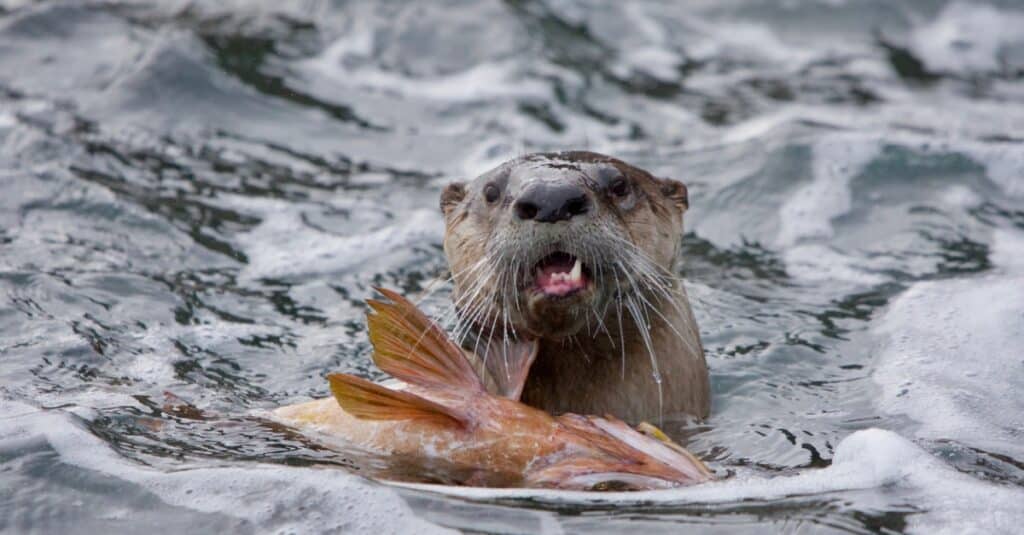
River otters regularly engage in playful behavior as a group
©iStock.com/DanielLacy
River otters live alone or in pairs, but they frequently gather in social groups. While together, they exhibit playful behavior, such as sliding and burrowing along river banks. This looks like fun and games, but this behavior strengthens social bonds and improves hunting ability. River otters use scent glands, urination, defecation, and scratching to mark territory. They spend time each day patrolling their territory, marking trees and rocks.
Habitat
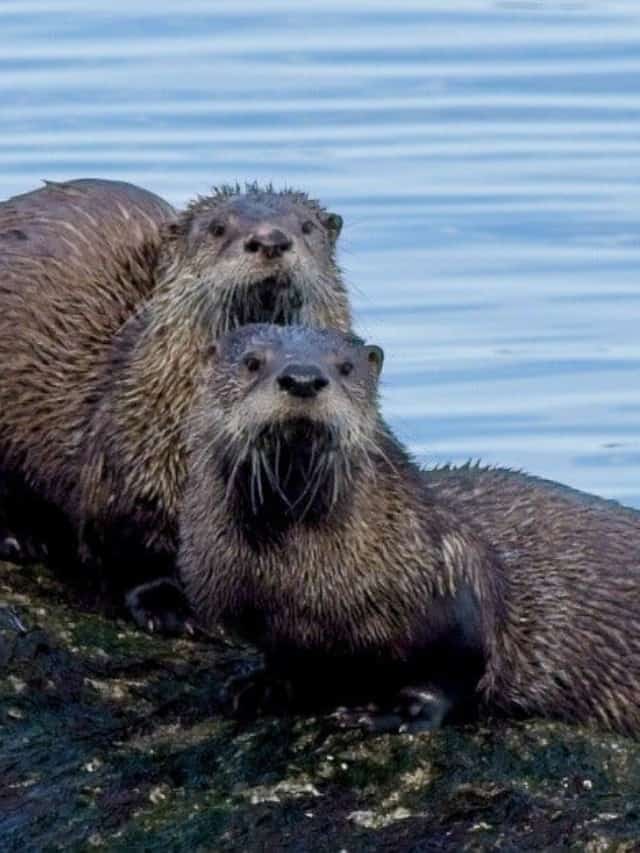
River otters are impressively adaptable but prefer clean water; they also prefer to avoid humans
©iStock.com/pr2is
River otters can live in either fresh or marine water. They make their homes in riparian zones, which are areas where land and water intersect. This can be along rivers, streams, ponds, lakes, and even marshes.
The river otter has adaptations that allow it to easily live in a range of climates, from hot to cold, and from coastal wetlands to higher elevations. What these mammals do not care for, however, is human disturbance. They are shy and prefer clean water, which leads them to areas where there is less pressure from civilization.
Despite spending so much time in the water, the river otter is able to thrive during cold weather. Hibernation makes sense for animals that spend so much of their life in water, but you may actually have better luck seeing a river otter in the winter than at other times of the year. During milder weather, it is mostly nocturnal, meaning most active at night.
During cold weather, however, they become diurnal, taking advantage of the warmer days to hunt and explore, and retreating to their nest for the night. If the surface of the water freezes, the otter is able to find cracks or weak areas to dive through and find food. Hibernation of other species may make finding meals more challenging. In the coldest months, crayfish, which do well in cold water, make up a substantial portion of the otter’s diet.
Diet
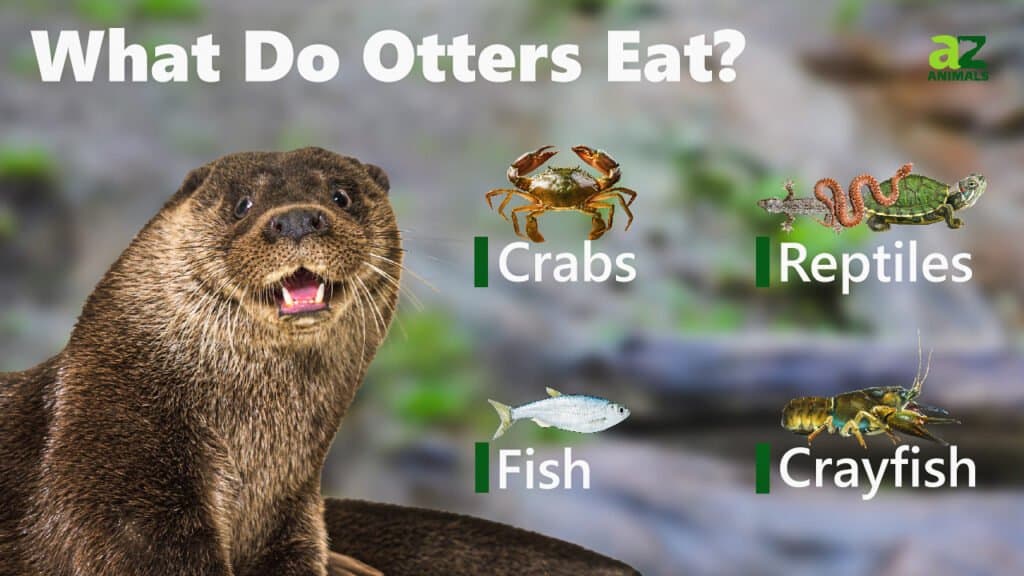
The otter’s location factors into its ideal diet. Fish is a preferred food, of course, but they also eat crayfish, snails, small turtles, freshwater clams, mussels, frogs, and salamanders. They can also make a meal out of small mammals, such as mice, as well as birds and bird eggs.
Predators and Threats

Black bears are just one category of predator otters have to keep a sharp lookout for
©BGSmith/Shutterstock.com
The greatest threat to this species is the loss of habitat. They prefer clear, clean water, which is often lost to development. Predators that they must watch out for include mountain lions, black bears, coyotes, wolves, and even alligators. In the water, the otter is nearly untouchable, with their strong, agile swimming skills and ferocious bite. Most risks they encounter are when they are lounging on dry land.
Reproduction and Life Cycle
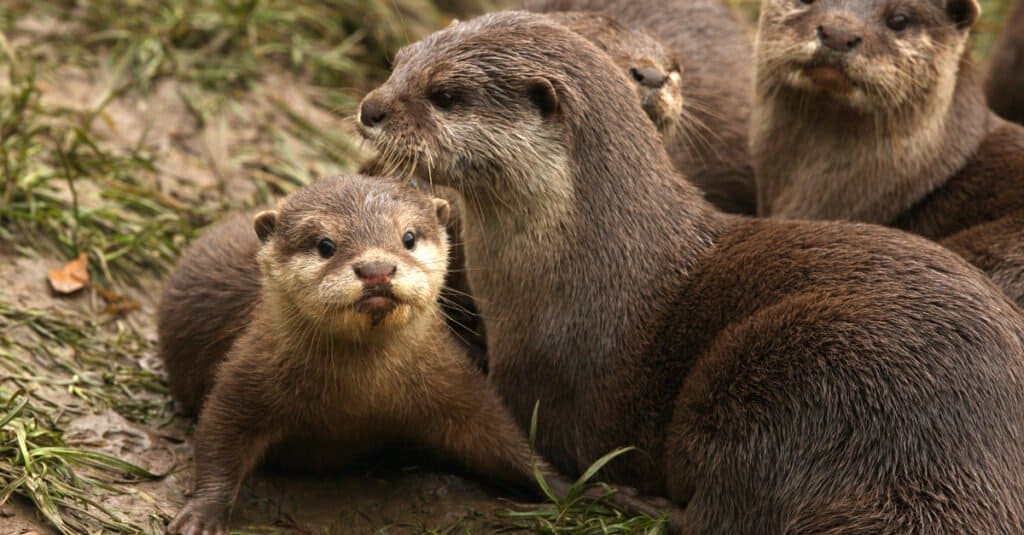
River otters nurse their pups for the first three months of their lives and remain with them for eight months
©scooperdigital/Shutterstock.com
The reproductive life cycle of the river otter isn’t clear. It is difficult to study these creatures in the wild, so scientists aren’t sure about many aspects of their mating rituals. There are some studies that indicate they mate for life, while others infer the coupling is only for a few months.
Once mating occurs, there is a delay in the implantation. Implantation can be delayed for nine to 11 months and is followed by a 60-day gestation period. Otters typically give birth in March and April. The newborn otters are born totally helpless, with their eyes closed and without teeth. During this period, the male who was present for mating is chased away from the den. He will return after the young are weaned and mobile. At that point, he will help raise the young.
The young stay in their nest for the first two months of their life. Once they leave the nest, they will continue to nurse for another month or so, even as they eat solid food. Natural swimmers, most pups require some initial encouragement from their mother before getting in the water for the first time.
One of the fun facts about these mammals is that they remain together as a family unit until the young are around 8 months old. At that point, the mother often has another litter, and the young are ready to move on. They will not be ready to have their own families for another year or two.
Population
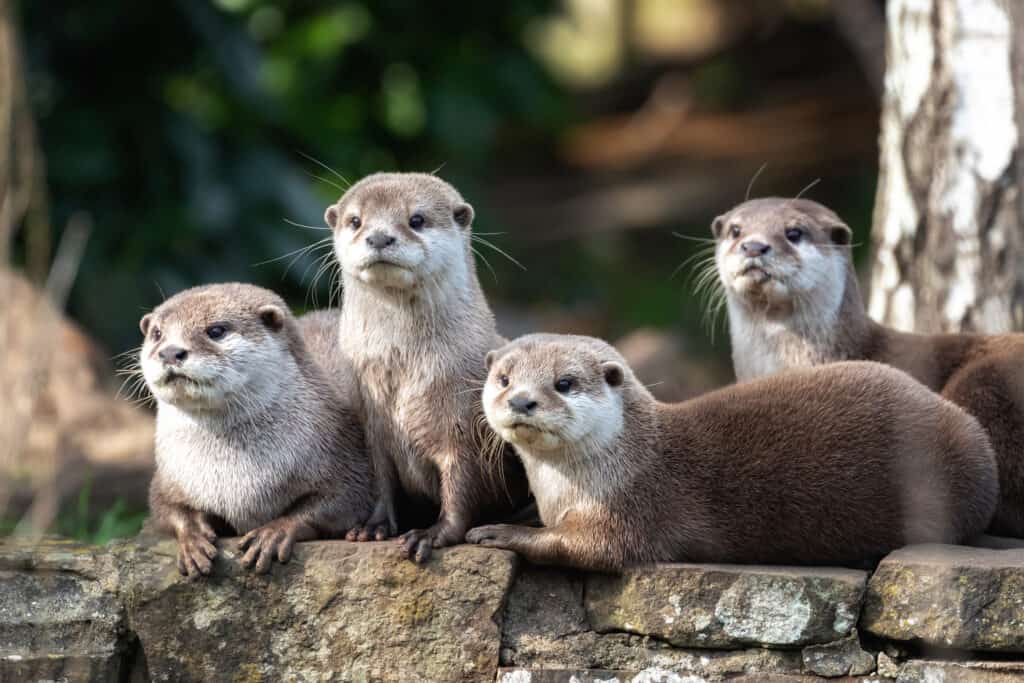
The population of North American river otters is currently stable
©iStock.com/Rixipix
It is estimated that there are around 100,000 North American otters. They are not considered endangered, as they are classified as Least Concerned and their population is stable.
View all 114 animals that start with RRiver Otter FAQs (Frequently Asked Questions)
What is a river otter?
A semi-aquatic mammal designed to thrive in cold water.
What does a river otter look like?
They have a thick coat of fur that protects them while swimming in cold rivers. Shedding is not an issue, but the otter spends a great deal of time grooming itself. Rubbing and rolling on grass and bark keep the coat in good condition, providing insulation and warmth in the often cold waters where they swim.
Their webbed feet, attached to short, strong legs, power them through the water. Overall, they have a narrow body that ends with a strong tail that acts as a rudder in the water.
How big is a river otter?
The river otter matures to around 18 pounds.
Are river otters friendly?
The river otter most often lives alone or as a pair, but they do socialize in larger groups. They are active and playful when interacting with each other. They are not aggressive towards humans, but will typically avoid encounters when possible.
Is it rare to see a river otter?
The North American river otter is plentiful from Canada and Alaska to the Rio Grande. As long as the area has trees and water, you can find the otter. However, they are shy and reclusive. As playful as they are with others of their kind, they are quick to slip away or into their dens when they hear humans. So, while the river otter is not a rare animal, it is rare to see one in the wild.
Where are river otters found?
The river otter, a North American species of otter, has a habitat that extends as far north as Canada and as far south as the Rio Grande River. They do not live in arid, desert areas or the tree-less arctic region. They are flexible about their aquatic habitat and can live in rivers, streams, ponds, lakes, and marshes.
Where do river otters make their nests?
The location of the river otter’s nest depends on a few things. The North American river otter may choose to build a nest in a burrow abandoned by another mammal. They can also make their nest in naturally occurring hollows, such as an area under a fallen log. Their nest includes an underwater entrance and exit point. From there, a tunnel leads to the nesting area, which they line with grass, bark, moss, leaves, and hair.
Where do river otters sleep at night?
River otters sleep on land, either in their nest or above ground. Their ability to make a speedy departure when necessary allows them to nap comfortably in the open. Along with their nest, individual North American river otters generally have several favorite lounging areas where they rest.
Thank you for reading! Have some feedback for us? Contact the AZ Animals editorial team.
Sources
- paws., Available here: https://www.paws.org/resources/river-otters/
- Smithsonian's National Zoo, Available here: https://nationalzoo.si.edu/animals/north-american-river-otter

















